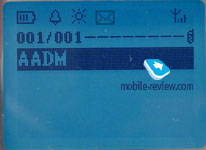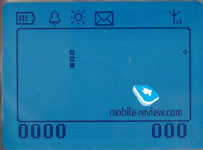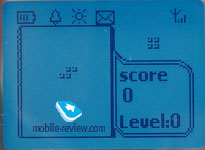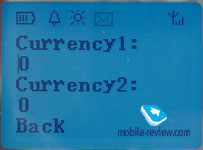Review Bird S288 and Zetta A10
Standard kit:
- Phone
- User's guide
- Charger
Bird has cooperated with Sagem for a long time, a lot of its phones are powered by Sagem’s platform. On the other hand, Bird produces its own handsets based on other manufacturer’s platforms for quite a while. And as a result, company’s sales grow from day to day on its native market, and it gains experience. It’s impossible to find any Bird’s phone around Europe, although in some segments it may be even competitive and successful, especially in the low-end one.

It’s difficult to identify a budget-type phone when you look at Bird s228. The phone is very thick, you’d pay more than 300$ just to get such kind of phone two years ago. Today there isn’t any low-end phone that can be compared with s228’s size. I have to admit that I’ve seen this model long time ago in one of the catalogues, at that moment I wasn’t neither impressed, nor interested in this model. However, when you see this phone in a real life it looks a lot better and leaves a very good impression. It’s very flat, there are even special phrases written on it’s sides and under the screen. Plastic’s quality is extremely high, not every business class phone can brag with such case. The design is also pretty unusual, symbolic arc on the phone’s top (second modification of this model, the only difference between them is the outlook) can be used for the phone strap.

The phone is very light, and fits the palm nicely. It’s weight is 60 grams, and it seems really comfortable. You can wear it wherever your want. The size is 110x44x11 mm. The weight is a lot lighter than other budget-class phones have. For example Samsung C100, which is advertised as the thickest phone around, is actually 17 mm thick.


The screen is graphical, it can display up to 4 text lines and an extra line for service needs. The backlight is blue, information is clearly seen even while it’s on. Screen’s resolution is 112x80 pixels.

The keypad has backlight as well. The keys are made of plastic. The keyboard’s convenience can be rated as average, most likely due to keys size, which varies.
500 mAh Li-on battery is shipped by default, it also plays the role of the back cover. Fastening is reliable, no backlash was encountered during testing. Bird claims that the phone can work up to 200 hours during stand by mode, and up to 2.5 hours during the talk. I used to talk for about 25-30 minutes daily, and the phone managed to work 2 days. However, if you talk about 15 minutes daily, it will work for three days, but it’s the best you can get from such battery.

Menu
The phone’s functions are typical for a low-end phone, it becomes obvious after entering the main menu (by pressing right soft-key). There are two lists of menu items provided with an animated icon for each item, just like in Maxon phones. In order to navigate through the menu you’ll have to use scroll button. Shortcut number navigation is not supported, although there is partial support of this function in sub-menus, however it’s not even worth mentioning. If you wish to enter selected menu item – just press Ok button, it’s located under the right soft key. Use the C button if you wish to exit the menu. Considering that soft-keys are used in sub-menu navigation as well, sometimes you might get confused. Unfortunately, the phone’s ergonomics doesn’t always match it’s outlook.


Phonebook. Up to 300 entries can be stored in the phonebook. Only one number can be assigned for each entry. Combined list for SIM-card and phone’s book entries doesn’t exist, you will have to select the book you need each time you’re doing a search, enter new contact etc. Sometimes it becomes rather annoying. In conclusion I must say that the phone book is very simple, and it doesn’t have anything special. The phone also supports contact groups, however the only use from this feature will be sending one sms to a group of people at once.



Call list can be accessed from the very same phone book menu. You can also access it by pressing Answer key.
Messages. The phone doesn’t have special memory dedicated to incoming/outgoing messages. SIM card’s memory is used for this purpose. Like I mentioned above – messages can be sent to several recipients at once, you can also define if you wish to send messages automatically, or manually proceeding each of them.

Services. Everything related to calls is amassed in this menu. (Redial, call forwarding etc.)
Settings. The phone supports only two languages: English and one additional, depending on the country. You can turn on vibrating alert, and choose one of 15 pre-installed melodies by using this menu as well. Strangely enough, the phone supports profiles, that can be modified as well.
Security. The name speaks for itself, all settings related to phone’s security are stored here.
Network. Voicemail setup, plus manual network select – these are the items located in this menu.
Games. The phone has three games – King Escape (logical game, another version of tag), Snake (classical Snake), Russian (Tetris).



Tools. Here you can setup the date and time. Screensaver gets activated whenever the phone is in stand by mode, it’s presented as a clock. Alarm Clock is pretty simple, meanwhile Calculator is very convenient and even has memory registers. Currency Converter is simple as well. Special battery-level indicator is here as well; although it can’t be considered as a useful tool because it has only four marks.



Impressions
Two phone’s network reception level is below the limit. This parameter didn’t pop-up in our reviews for a long time, but in this case it’s really low. When you’re walking around in a big city – you will not feel anything going wrong, however, this will last only until there are a lot of base stations around. If you will enter a building that lacks windows, the phone’s network reception level will immediately go down, and you will not be able to make a decent phone call.
The sound is synthesized into warm tones, however contrary noise can sometimes drive you dizzy. Most likely it’s because the manufacturers decided not to shielding for the display, because it could have affected the phone’s size. Vibrating alert is above average, and you can feel the phone ringing almost everywhere. Ring tones sound rather poor, it’s because they are 4-tone polyphonic, it’s very rude and loud.
Considering the phones functionality I will sum it up as a typical budget phone with minimum functions on board and a cute-looking design. The phone will most likely be popular only during the first days of sales, later on there won’t be any demand for it. If you wish to have an original phone, and you don’t need any extra functions – then this model is made for you, but keep in mind it’s network reception quality. If I was asked to describe this phone in 4 words, I’d say the following: bought, sold and forgot.
The model with symbolic arc on the top will cost about 100$, meanwhile Bird S288 will be a bit more expensive, 110$. We’d like to see other models from Bird as well, this company is in the lead at it’s native market leaving behind such brands as Nokia and Motorola.
No comments:
Post a Comment